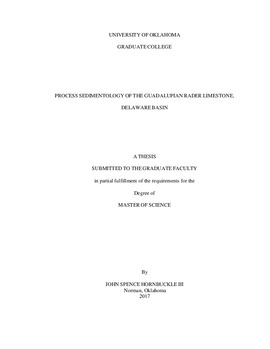| dc.contributor.advisor | Pigott, John | |
| dc.contributor.author | Hornbuckle, John | |
| dc.date.accessioned | 2017-04-11T15:03:11Z | |
| dc.date.available | 2017-04-11T15:03:11Z | |
| dc.date.issued | 2017 | |
| dc.identifier.uri | https://hdl.handle.net/11244/50431 | |
| dc.description.abstract | An integrated LiDAR, XRF, Spectral Gamma Ray, and outcrop investigation was performed on the upper Guadalupian Rader Formation in the Delaware Basin of West Texas. The Rader Formation, is an upper slope carbonate submarine fan deposit that is divided into three units: the lower, middle and upper Rader intervals. The lower and upper Rader intervals are characterized by thin to thick, ungraded and graded skeletal and non-skeletal allochthonous deposits interpreted to be highstand carbonate apron deposits. These intervals are interpreted to have been deposited by grain flows and high density turbidite flows. The middle Rader unit has an erosive base and consists of ungraded matrix supported mega conglomerates and megabreccias as well as intervals of clast supported megabreccias representing a lowstand period which resulted in a catastrophic platform failure due to increasing stress of platform sediments as water level fell. The mega conglomerate and mega breccia of the middle Rader were deposited as debris flows. Lack of oiids, pisolites and fenestral fabrics within the Rader Formation indicate that more distant restricted back reef environments were not affected by the catastrophic platform failure, however, submarine cement coated grains and fusulinids observed in the middle Rader deposits indicate that the reef crest is the most proximal environment affected by the catastrophic slope failure. Of particular consequence is the presence of hummocky cross stratification observed within the Bull Head Turbidite which directly overlies the mega conglomerate deposits. The hummocky cross stratification is interpreted to be evidence of a tsunamiite generated by massive subaqueous debris flows caused by the platform failure responsible for the deposition of the mega conglomerate and mega breccia deposits. | en_US |
| dc.language | en | en_US |
| dc.subject | Sedimentology Geology Delaware Basin | en_US |
| dc.title | PROCESS SEDIMENTOLOGY OF THE GUADALUPIAN RADER LIMESTON, DELAWARE BASIN | en_US |
| dc.contributor.committeeMember | Slatt, Roger | |
| dc.contributor.committeeMember | Pigott, Kulwadee | |
| dc.date.manuscript | 2017 | |
| dc.thesis.degree | Master of Science | en_US |
| ou.group | Mewbourne College of Earth and Energy::Conoco Phillips School of Geology and Geophysics | en_US |
| shareok.nativefileaccess | restricted | en_US |
